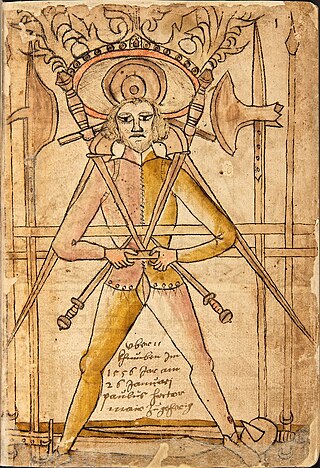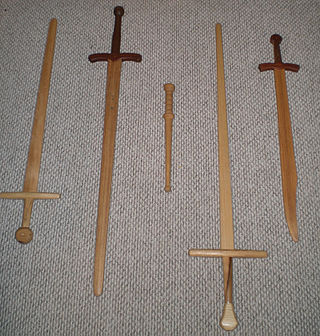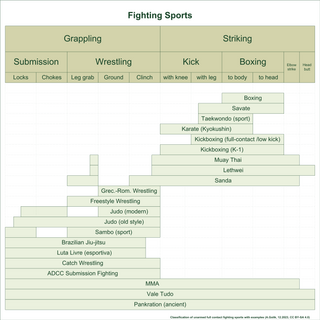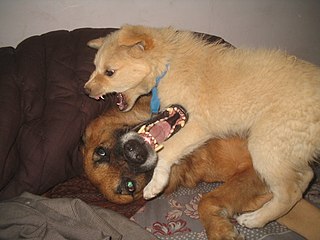
Martial arts are codified systems and traditions of combat practiced for a number of reasons such as self-defence; military and law enforcement applications; competition; physical, mental, and spiritual development; entertainment; and the preservation of a nation's intangible cultural heritage.

Historical reenactments is an educational or entertainment activity in which mainly amateur hobbyists and history enthusiasts dress in historic uniforms and follow a plan to recreate aspects of a historical event or period. This may be as narrow as a specific moment from a battle, such as the reenactment of Pickett's Charge presented during the 1913 Gettysburg reunion, or as broad as an entire period, such as Regency reenactment.

Jousting is a medieval and renaissance martial game or hastilude between two combatants either on horse or on foot. The joust became an iconic characteristic of the knight in Romantic medievalism.

Stage combat, fight craft or fight choreography is a specialised technique in theatre designed to create the illusion of physical combat without causing harm to the performers. It is employed in live stage plays as well as operatic and ballet productions. With the advent of cinema and television the term has widened to also include the choreography of filmed fighting sequences, as opposed to the earlier live performances on stage. It is closely related to the practice of stunts and is a common field of study for actors. Actors famous for their stage fighting skills frequently have backgrounds in dance, gymnastics or martial arts training.

Swordsmanship or sword fighting refers to the skills and techniques used in combat and training with any type of sword. The term is modern, and as such was mainly used to refer to smallsword fencing, but by extension it can also be applied to any martial art involving the use of a sword. The formation of the English word "swordsman" is parallel to the Latin word gladiator, a term for the professional fighters who fought against each other and a variety of other foes for the entertainment of spectators in the Roman Empire. The word gladiator itself comes from the Latin word gladius, which is a type of sword.

Historical European martial arts (HEMA) are martial arts of European origin, particularly using arts formerly practised, but having since died out or evolved into very different forms.

In martial arts, a waster is a practice weapon, usually a sword, and usually made out of wood, though nylon (plastic) wasters are also available. Nylon is safer than wood, due to it having an adequate amount of flex for thrusts to be generally safe, unlike wooden wasters. Even a steel feder has more flex than most wooden wasters. The use of wood or nylon instead of metal provides an economic option for initial weapons training and sparring, at some loss of genuine experience. A weighted waster may be used for a sort of strength training, theoretically making the movements of using an actual sword comparatively easier and quicker, though modern sports science shows that an athlete would most optimally train with an implement which is closest to the same weight, balance, and shape of the tool they will be using. Wasters as wooden practice weapons have been found in a variety of cultures over a number of centuries, including ancient China, Ireland, Iran, Scotland, Rome, Egypt, medieval and renaissance Europe, Japan, and into the modern era in Europe and the United States. Over the course of time, wasters took a variety of forms not necessarily influenced by chronological succession, ranging from simple sticks to clip-point dowels with leather basket hilts to careful replicas of real swords.

A combat sport, or fighting sport, is a contact sport that usually involves one-on-one combat. In many combat sports, a contestant wins by scoring more points than the opponent, submitting the opponent with a hold, disabling the opponent, or attacking the opponent in a specific or designated technique. Combat sports share a long history with the martial arts.

Medieval reenactment is a form of historical reenactment that focuses on re-enacting European history in the period from the fall of Rome to about the end of the 15th century. The second half of this period is often called the Middle Ages. This multiplicity of terms is compounded by the variety of other terms used for the period.
Association for Renaissance Martial Arts (ARMA) is a US-based non-profit organization dedicated to the study and practice of historical European martial arts of the 15th to 17th centuries.
Rapier Combat is a style of historical fencing practiced in the Society for Creative Anachronism (SCA). The primary focus is to study, replicate and compete with styles of rapier sword-fighting found in Europe during the Renaissance period, using blunted steel swords and a variety of off-hand defensive items. Participants wear period clothing while competing, along with or incorporating protective equipment for safety. In the April 2020 update of the rules, the sport was renamed 'Fencing Combat'.
The Society for Creative Anachronism (SCA) is a medieval reenactment group with an international membership, founded in California in 1966. Members of the group participate, to a greater or lesser extent, in a wide variety of activities based on those found in pre-1601 CE cultures. The vast majority of interests in the SCA are either combat-focused, or focused on the day-to-day crafts of the period, known within the Society as A&S. Gatherings of the SCA are events, at which attempts at pre-17th century costume must be worn, and practices or meetings, at which costuming is largely up to each member's discretion—although sufficient safety equipment must always be worn for practicing combat skills.
Cinematic fight choreography or staged fights in cinema include performances of archery, classical fencing, historical fencing, martial arts, close combat, and duels in general, as well as choreography of full-scale battles with hundreds of combatants.

Mock combat involves the execution of combative actions without intent to harm. Participants can engage in such sparring for ritual, training, recreational or performance reasons. The nature of mock combat can vary from realistic to symbolic. Mock combat can be classified into choreographed and unchoreographed forms.
The oldest surviving manual on western swordsmanship dates back to the 14th century, although historical references date fencing schools back to the 12th century.
Hanlon-Lees Action Theater is an American entertainment company credited with the development of theatrical jousting. The company was formed in 1979 by partners Kent Shelton, Robin Wood, Richard "Dikki" Ellis, R. Vincent Park, Taso N. Stavrakis, and Stephen "Omms" Ommerle.

Theatrical jousting is a form of live entertainment in which a medieval jousting tournament is recreated in conjunction with a scripted performance. Alternative terms are jousting reenactment and choreographed jousting.

SCA armoured combat, or informally heavy combat, is a combat sport developed by the Society for Creative Anachronism (SCA) in which participants in protective body armour compete in mock combat, individual tournaments inspired by forms of historical combat, and tournament combat practiced in medieval Europe. Groups also compete, under supervision, in group battles which may approximate historically real combat, using SCA approved safe weapons. Combats are performed under the watch of marshals to maintain safety. It is variously considered a combat sport, contact sport, or a form of martial art.
Historical Medieval Battles (HMB) or Buhurt or Armored Combat is a modern full contact fighting sport with steel blunt weapons characteristic for the Middle Ages. Armour and weapons have to follow regulations on historical authenticity and safety published on official Battle of the Nations website.

John Waller was an English pioneer of the historical European martial arts (HEMA) revival, a fight director for stage, screen and spectacle, and a teacher of martial arts.















